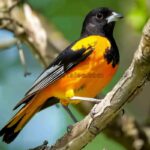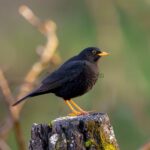Appearance and Identification
American robins are easily identifiable birds with distinctive features.
Their appearance varies slightly between males and females, making them interesting to observe.
Let’s explore what makes these birds unique.
Distinctive Features
American robins are small birds, about the size of a common grackle.
Their round bodies, long legs, and pointed beaks make them easy to spot.
Males sport a black head, white eye arcs, and a rich red breast, making them stand out.
Females, on the other hand, are more subdued with a brown head and breast.
This difference in color helps to identify them in the wild.
These birds have brown backs and white lower bellies.
Their throats are white with black streaks.
When you see American robin, the first thing you’ll notice is its bright reddish-orange breast, which is a signature trait.
They also have a distinctive hopping movement when they are on the ground, searching for food.
Hawks are strong birds of prey from the family Accipitridae. They are found on every continent except Antarctica. These birds…
Male vs. Female American Robins
Male American robins are more colorful.
Their heads are black, and their breasts are a vivid red.
They also have white eye arcs that are more pronounced.
Females are plainer.
Their heads and breasts are brown.
This difference in appearance is due to the males needing to attract females during the breeding season.
In contrast, the females’ duller colors help them stay hidden from predators while nesting.
| Feature | Male | Female |
|---|---|---|
| Head Color | Black | Brown |
| Breast Color | Rich Red | Dull Red |
| Eye Arcs | Pronounced White | Less Prominent |
| Overall Brightness | Bright | Subdued |
Habitat and Distribution
American robins are highly adaptable birds, thriving in a variety of environments across North America.
Their ability to live in different habitats makes them a common sight in many regions.
Parrots are intelligent and colorful birds with strong beaks and unique feet. They are found in warm regions around the…
Common Habitats
American robins are incredibly adaptable.
They can be found in various habitats, including forests, parks, gardens, and even backyards.
They are particularly fond of areas with short grass and scattered trees, making lawns a favorite spot.
You might see them hopping around, pulling up earthworms.
They also enjoy areas with shrubs, which provide cover and nesting sites.
Seasonal Distribution
American robins are flexible in their movements.
While some migrate south for the winter, others stay put year-round.
Their migration depends on the location and weather conditions.
In spring, you will often hear their cheery songs as they return to their breeding grounds.
In winter, some robins head to warmer areas, but others stay if food is available.
| Season | Location |
|---|---|
| Spring | Backyards, Gardens, Forests |
| Winter | Southern Regions, Backyards |
Orioles are a group of colorful birds found across North America. Each species has unique features and habits. This article…
Diet and Feeding Habits
The diet of American robins changes with the seasons.
These birds are skilled foragers, adapting their food sources based on availability.
Spring and Summer Diet
In spring and summer, American robins have a varied diet.
They primarily eat earthworms and insects.
American robins are skilled at spotting tiny disturbances in the soil, which indicate earthworms.
You might see them standing still, then suddenly darting forward to pull an earthworm from the ground.
They also eat caterpillars, beetles, and other small insects.
These foods provide the protein they need for breeding and raising chicks.
Fall and Winter Diet
As the seasons change, so does their diet.
In fall and winter, American robins switch to eating fruits and berries.
They can often be seen in trees and bushes, feasting on these foods.
This seasonal change helps them survive when insects and earthworms are less available.
Common foods include berries from juniper, sumac, and dogwood.
Their ability to switch diets makes them very adaptable.
| Season | Primary Food |
|---|---|
| Spring/Summer | Earthworms, Insects |
| Fall/Winter | Fruits, Berries |
Behavior and Song
American robins are known for their distinct behaviors and melodious songs.
Their actions and vocalizations are key to understanding these birds.
Territorial Behavior
American robins are known for their territorial nature.
During the breeding season, males become very protective of their nesting sites.
They will defend their territory against other robins and even other bird species.
You might see a american robin chasing away an intruder with flapping wings and loud calls.
This behavior ensures they have enough resources to raise their young.
Singing and Vocalizations
One of the most charming traits of the American robin is its song.
Males sing their cheery songs throughout the day, especially in spring.
Their song is a series of clear whistles, often described as a cheer-up, cheerily melody.
This caroling song signals the arrival of spring and is a familiar sound in many neighborhoods.
American robins also have other calls, including a sharp “tut” used as an alarm signal.
Migration Patterns
American robins exhibit varied migration behaviors.
Some migrate seasonally, while others remain in the same area year-round.
Migratory vs. Resident American Robins
Robins have different migration habits.
Some are migratory, moving south in winter, while others are residents, staying in the same area all year.
Their decision to migrate depends on food availability and weather.
In areas where winters are mild and food is plentiful, American robins may not migrate.
However, in colder regions, they often head to warmer climates to find food.
| Type | Description |
|---|---|
| Migratory | Move south during winter |
| Resident | Stay in the same area year-round |
The American robin is a fascinating bird with distinct features and behaviors.
Their adaptability, cheerful song, and presence in various habitats make them a favorite among birdwatchers.
Conclusion
The American robin is a familiar and beloved bird species in North America.
Their bright colors, pleasant songs, and presence in backyards make them a favorite among birdwatchers.
Observe and appreciate these birds in their natural habitats.





